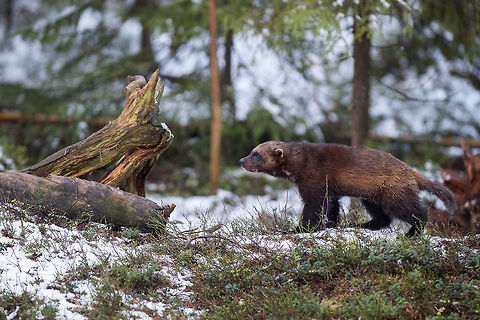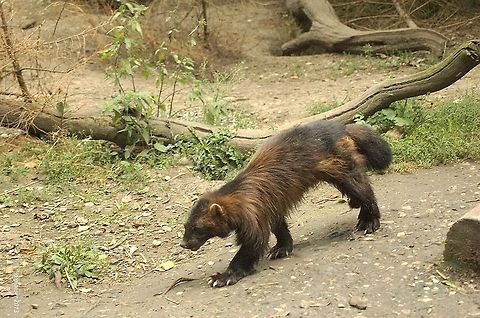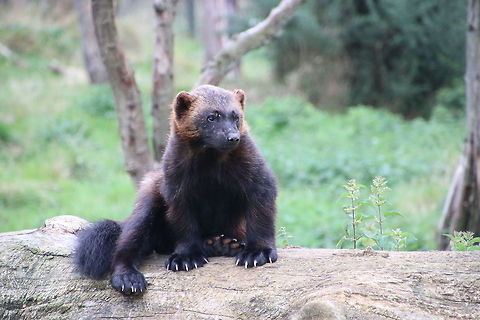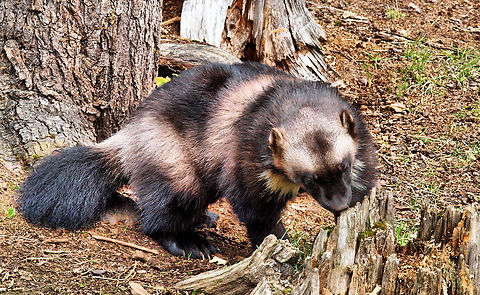
Appearance
Anatomically, the wolverine is a stocky and muscular animal. With short legs, broad and rounded head, small eyes and short rounded ears, it resembles a bear more than other mustelids. Though its legs are short, its large, five-toed paws and plantigrade posture facilitate movement through deep snow.The adult wolverine is about the size of a medium dog, with a length usually ranging from 65–107 cm, a tail of 17–26 cm, and a weight of 9–25 kg, though exceptionally large males can weigh up to 32 kg. The males are as much as 30% larger than the females and can be twice the females' weight. Shoulder height is reported from 30 to 45 cm. It is the largest of terrestrial mustelids; only the marine-dwelling sea otter and giant otter of the Amazon basin are larger.
Wolverines have thick, dark, oily fur which is highly hydrophobic, making it resistant to frost. This has led to its traditional popularity among hunters and trappers as a lining in jackets and parkas in Arctic conditions. A light-silvery facial mask is distinct in some individuals, and a pale buff stripe runs laterally from the shoulders along the side and crossing the rump just above a 25–35 cm bushy tail. Some individuals display prominent white hair patches on their throats or chests.
Like many other mustelids, it has potent anal scent glands used for marking territory and sexual signaling. The pungent odor has given rise to the nicknames "skunk bear" and "nasty cat." Wolverines, like other mustelids, possess a special upper molar in the back of the mouth that is rotated 90 degrees, towards the inside of the mouth. This special characteristic allows wolverines to tear off meat from prey or carrion that has been frozen solid.

Naming
The wolverine's questionable reputation as an insatiable glutton may be in part due to a false etymology. The animal's name in Old Swedish, "fjellfräs", meaning "mountain cat", worked its way into German as "Vielfrass", which means roughly "devours much". Its name in other West Germanic languages is similar.The Finnish name is "ahma", derived from "ahmatti," which is translated as "glutton". Similarly, the Estonian name is "ahm", with the equivalent meaning to the Finnish name. In Lithuanian is "ernis", in Latvian—"tinis" or "āmrija".
The Eastern Slavic росомаха and the Polish and Czech name "rosomak" seem to be borrowed from the Finnish "rasva-maha". Similarly, the Hungarian name is "rozsomák" or "torkosborz" which means "gluttonous badger".
In French-speaking parts of Canada, the wolverine is referred to as "carcajou", borrowed from the Innu-aimun or Montagnais "kuàkuàtsheu". However in France, the wolverine's name is "glouton".
Purported gluttony is reflected neither in English nor in North Germanic languages. The English word wolverine probably implies "a little wolf". The name in Proto-Norse, "erafaz" and Old Norse, "jarfr", lives on in the regular Icelandic name "jarfi", regular Norwegian name "jerv", regular Swedish name "järv" and regular Danish name "jærv".

Behavior
The wolverine is a powerful and versatile predator and scavenger. Prey mainly consists of small to large-sized mammals, but the wolverine has been recorded killing prey such as adult deer that are many times larger than itself. Prey species include porcupines, squirrels, beavers, marmots, rabbits, voles, mice, shrews, lemmings, caribou, roe deer, white-tailed deer, mule deer, sheep, moose, and elk. Smaller predators are occasionally preyed on, including martens, mink, foxes, Canada lynx, weasels, Eurasian lynx, and coyote and wolf pups. Wolverines often pursue live prey that are relatively easy to obtain, including animals caught in traps, newborn mammals, and deer when they are weakened by winter or immobilized by heavy snow. Their diets are sometimes supplemented by birds' eggs, birds, roots, seeds, insect larvae, and berries. A majority of the wolverine's sustenance is derived from carrion, on which they depend almost exclusively in winter and early spring. Wolverines may find carrion themselves, feed on it after the predator is done feeding or simply take it from another predator. Whether eating live prey or carrion, the wolverine's feeding style appears voracious, leading to the nickname of "glutton". However, this feeding style is believed to be an adaptation to food that is scarcely encountered, especially in the winter.Armed with powerful jaws, sharp claws, and a thick hide, wolverines, like most mustelids, are remarkably strong for their size. They may defend kills against larger or more numerous predators such as wolves or bears. At least one account reported a 12 lb wolverine's apparent attempt to steal a kill from a black bear ), although the bear won what was ultimately a fatal contest. In another account, a wolverine attacked a polar bear and clung to its throat until the bear suffocated. While wolverines have dominated wolves in competitions over a carcass, some wolves become habituated to preying on wolverines and, in such cases, wolves may lead to a complete absence of wolverines in a given area.
Wolverines inhabiting the Old World are more active hunters than their North American relatives. This may be because competing predator populations in Eurasia are not as dense, making it more practical for the wolverine to hunt for itself than to wait for another animal to make a kill and then try to snatch it. They often feed on carrion left by wolves, so changes in the population of wolves may affect the population of wolverines. Wolverines are also known on occasion to eat plant material.
Successful males will form lifetime relationships with two or three females, which they will visit occasionally, while other males are left without a mate. Mating season is in the summer, but the actual implantation of the embryo in the uterus is stayed until early winter, delaying the development of the fetus. Females will often not produce young if food is scarce. The wolverine gestation period is 30–50 days. Litters of typically two or three young are born in the spring. Kits develop rapidly, reaching adult size within the first year of a lifespan that may reach anywhere from five to 13 years. Fathers make visits to their offspring until they are weaned at 10 weeks of age; also, once the young are about six months old, some reconnect with their fathers and travel together for a time.

Cultural
Many cities, teams, and organizations use the wolverine as a mascot. For example, the US state of Michigan is, by tradition, known as "the Wolverine State", and the University of Michigan takes the wolverine as its mascot. The association is well and long established: for example, many Detroiters volunteered to fight during the American Civil War and George Armstrong Custer, who led the Michigan Brigade, called them the "Wolverines". The origins of this association are obscure; it may derive from a busy trade in wolverine furs in Sault Ste. Marie in the 18th century or may recall a disparagement intended to compare early settlers in Michigan with the vicious mammal. Wolverines are, however, extremely rare in Michigan. A sighting in February 2004 near Ubly was the first confirmed sighting in Michigan in 200 years. The animal was found dead in 2010 and the story recounted in the book "The Lone Wolverine".The wolverine figures prominently in the mythology of the Innu people of eastern Québec and Labrador. In at least one Innu myth, it is the creator of the world.
Wolverine is the name of a popular fictional character by Marvel Comics—named for his highly individualistic and aggressive behavior, as well as his great ferocity despite his small stature.
References:
Some text fragments are auto parsed from Wikipedia.